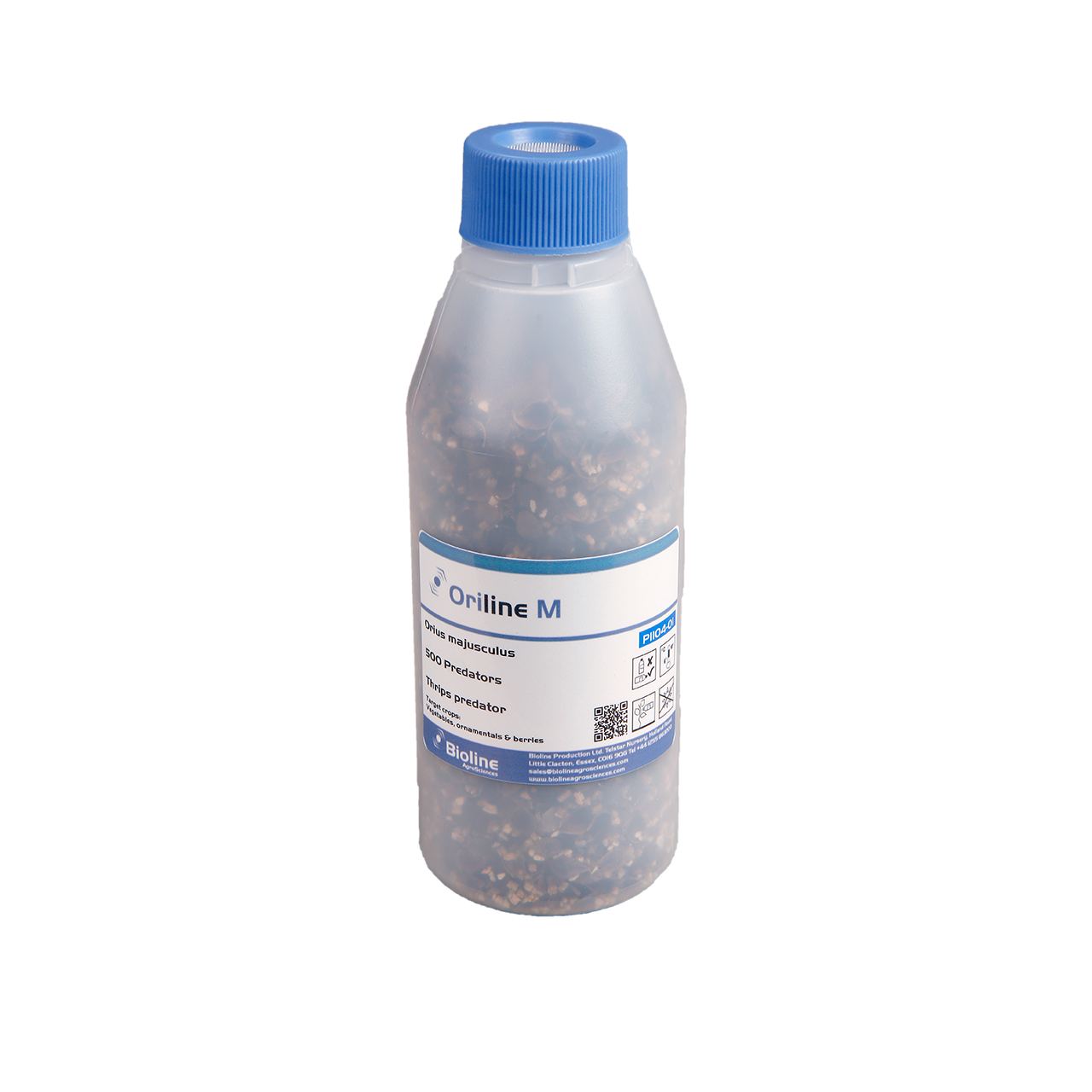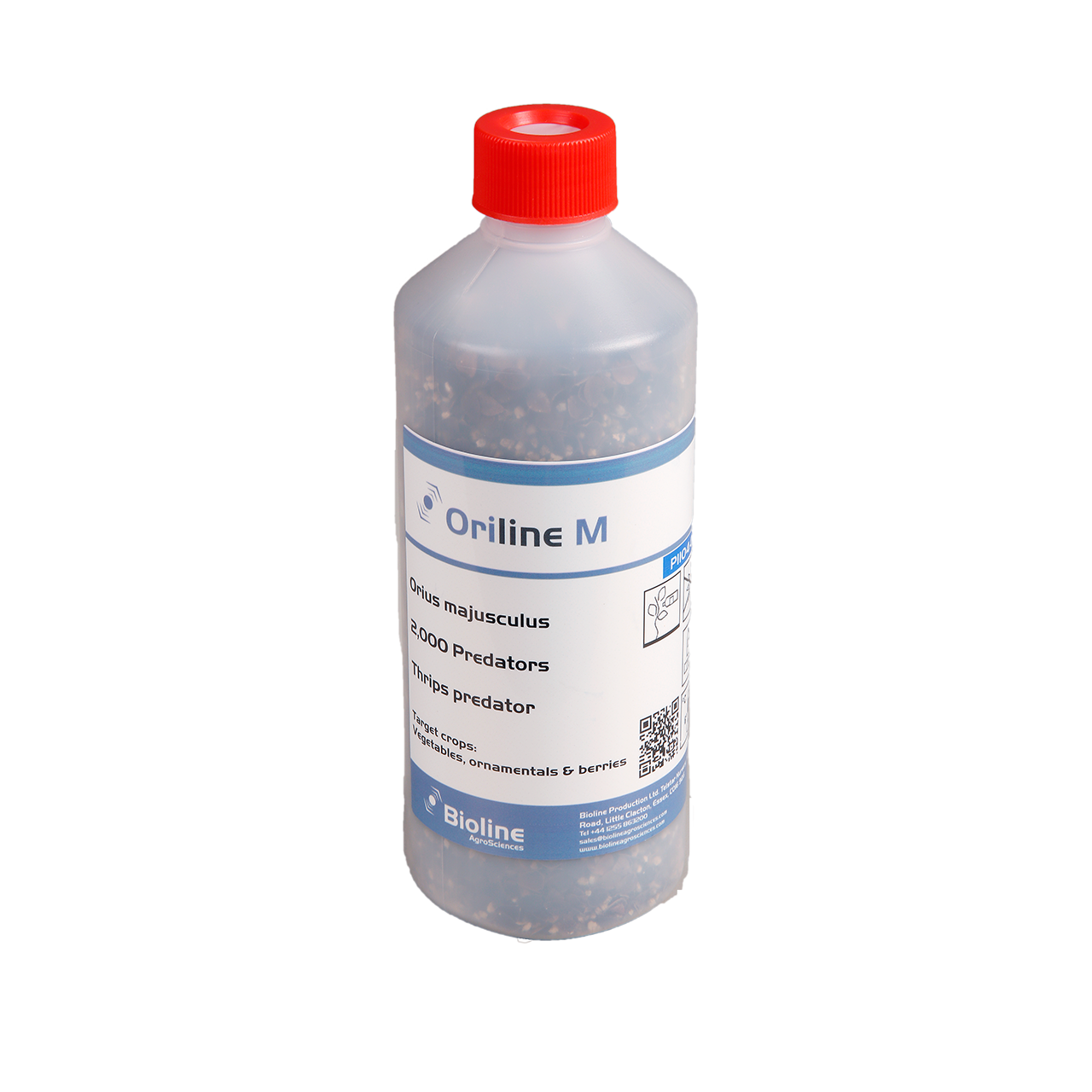Western Flower Thrips (Frankliniella occidentalis);
Tobacco thrips (Thrips tabaci);
Red spider mite (Tetranychus urticae);
Whiteflies (Aleyrodidae);
Moths eggs (Lepidoptera)
Aphids.
Pepper, cucumber, eggplant, wild strawberry, strawberry.
250 ml bottle contains 500 adults on vermiculite and buckwheat husk;
500 ml bottle contains - 2,000 nymphs, 4th and 5th instars, on vermiculite and buckwheat husk.
Brown-black imago with gray spots is very small (2.5- 3 mm long), somewhat flattened teardrop-shaped. The body is smaller than Orius levigatus’ one. The head is tiny with expressive eyes and a piercing-sucking mouth apparatus (proboscis). During development, the larva darkens and becomes pale orange to light brown. At the same time, the body shape remains unchanged during all the ontogenesis. With each subsequent molt, the wing rudiments become larger after the molt and the larva turns out into a winged imago. Orius majusculus color varies depending on the species. Males have a curved abdomen.
Orius levigatus has 7 instars of ontogenesis: egg, 5 instars, adult. In the absence of food, the predator can enter diapause. Before the predator becomes an adult, it passes through 5 larval instars, and at 20 ° C, development from egg to adult takes about 25 days, at 24 ° C it decreases to 15 days, and at 28 ° C it takes only 9 days.
Females lay tiny eggs into plant tissues underneath leaves. The egg is almost entirely embedded in the tissues of plants, with only the top visible on the surface. After depositing the egg is colorless, then it becomes milky-white. Its size is 0.4mm by 0.13mm. Females lay an average of 120 -150 eggs during their life spans (approximately 1-3 eggs per day). Most eggs are laid in the first two weeks of life. Eggs are laid separately (individually) and after about 4 days at 25 °C, the first nymphs appear.
The 1st instar nymphs are shiny and colorless. In a few hours, the nymph becomes a yellowish color, which is preserved throughout the 2d and 3d instars of the nymph. In the 4th and 5th stages, the coloration becomes dark brown and their bodies look like adults. Nymphs and imago have a flattened body that allows them to penetrate flower buds and between petals.
| Time of pre-imaginal development (days) at a constant temperature ° С | |||||
|---|---|---|---|---|---|
| Temperature, °С | 15 | 20 | 25 | 30 | 35 |
| Time,days | 60 | 25 | 15 | 9 | 13 |
The female can consume 60-70 thrips per day and the nymph can consume 25 -30 ones. With an excess of food, Orius majusculus kills more victims than it can eat. These beneficial insects are omnivorous, they can feed on pollen and plant sap, as well as various types of thrips, aphids, whiteflies, mites, and moth eggs.
Beneficial insects should be applied at closed greenhouse windows, preferably in the early morning or evening. Avoid direct sunlight. Spread the contents all over the crop by lightly tapping and rolling the bottle or in any other way that your consultant advises. During preventive release into biological rows, it is necessary to feed the entomophage with mixtures additionally.
| Infection degree | Prevention | Small | Average | High |
|---|---|---|---|---|
| Application rate of individuals / m2 | 0,5 | 1 | 5 | 10 |
| Interval, days | 7-14 | 7-14 | 7 | – |
| Notes | Once application if there is pollen in the crop | 2 applications | 2 applications | In outbreaks |
The recommended applying standards and their number depend on the crop, conditions in the glasshouse, and the presence of pests. For more information, please contact the specialists.


Оставить комментарий